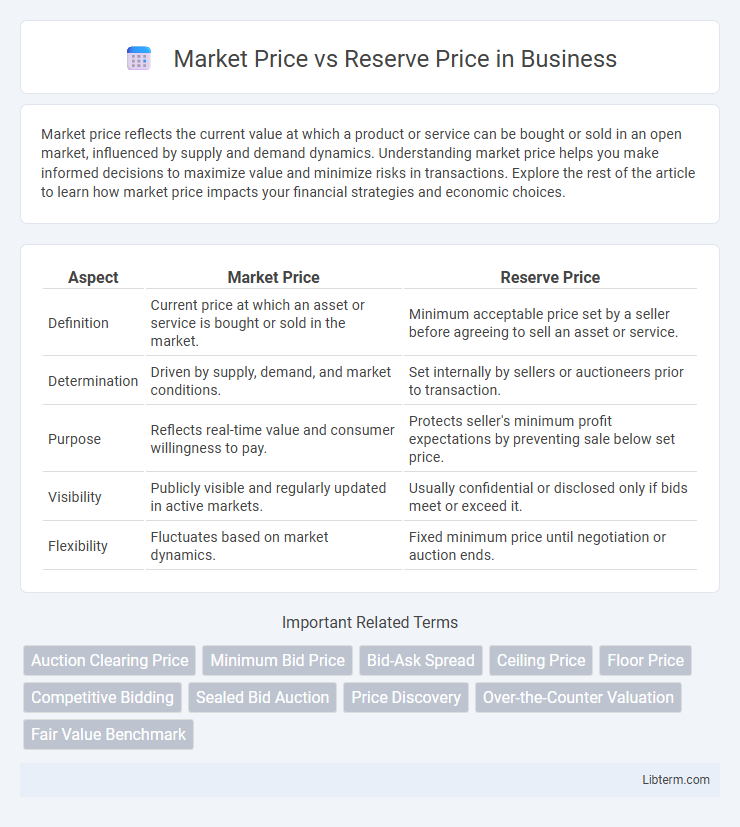Market price reflects the current value at which a product or service can be bought or sold in an open market, influenced by supply and demand dynamics. Understanding market price helps you make informed decisions to maximize value and minimize risks in transactions. Explore the rest of the article to learn how market price impacts your financial strategies and economic choices.
Table of Comparison
| Aspect | Market Price | Reserve Price |
|---|---|---|
| Definition | Current price at which an asset or service is bought or sold in the market. | Minimum acceptable price set by a seller before agreeing to sell an asset or service. |
| Determination | Driven by supply, demand, and market conditions. | Set internally by sellers or auctioneers prior to transaction. |
| Purpose | Reflects real-time value and consumer willingness to pay. | Protects seller's minimum profit expectations by preventing sale below set price. |
| Visibility | Publicly visible and regularly updated in active markets. | Usually confidential or disclosed only if bids meet or exceed it. |
| Flexibility | Fluctuates based on market dynamics. | Fixed minimum price until negotiation or auction ends. |
Understanding Market Price and Reserve Price
Market price represents the current value at which an asset or commodity is bought and sold in the open market, reflecting real-time supply and demand dynamics. Reserve price is the minimum acceptable price set by the seller or auctioneer, ensuring that the asset is not sold below a predetermined threshold. Understanding the distinction between market price and reserve price is crucial for buyers and sellers to make informed decisions and achieve fair transactions.
Key Differences Between Market Price and Reserve Price
Market price represents the current value at which an asset or commodity is bought and sold in an open market, reflecting real-time supply and demand dynamics. Reserve price is the minimum acceptable price set by the seller, ensuring that the asset will not be sold below this threshold during an auction. Unlike market price, reserve price is a seller-driven figure often kept confidential until bidding concludes.
Factors Influencing Market Price
Market price is determined by supply and demand dynamics, buyer sentiment, and competitive bidding in the marketplace. Economic indicators, such as inflation rates and interest levels, directly affect consumers' purchasing power, influencing market price fluctuations. External factors like seasonal trends, geographic location, and product rarity also play critical roles in establishing the market price.
Factors Affecting Reserve Price
Reserve price is influenced by factors such as market demand, seller's valuation, and item uniqueness. Economic conditions and competitive auctions also play key roles in determining the minimum acceptable price. Understanding these variables helps sellers set a realistic reserve price that aligns with current market trends.
Importance of Reserve Price in Auctions
The reserve price in auctions serves as the minimum acceptable bid that protects the seller from underselling valuable assets. Setting an appropriate reserve price ensures the auction achieves a market value aligned with the asset's worth, preventing losses. This strategic threshold balances attracting competitive bids while safeguarding the seller's financial interests.
How Market Price is Determined
Market price is determined by the interaction of supply and demand forces within a competitive marketplace, reflecting the highest price buyers are willing to pay and the lowest price sellers are willing to accept. Factors influencing market price include current market conditions, product availability, consumer preferences, and external economic indicators such as inflation and interest rates. Unlike the reserve price set by sellers as the minimum acceptable value, market price fluctuates dynamically based on real-time transactions and bids.
Impact of Reserve Price on Buyer Behavior
The reserve price in auctions sets a hidden minimum threshold that directly influences buyer behavior by signaling seller expectations and value perception. Buyers often adjust their bidding strategies, either aggressively bidding close to or above the reserve price if it is perceived as fair, or hesitating to bid if the reserve price appears inflated, potentially limiting competition. This psychological impact can lead to fewer bids, affecting final market prices and sometimes causing items to remain unsold if the reserve price is not met.
Role of Market Forces in Price Formation
Market price reflects the value determined by supply and demand dynamics within an open marketplace, where buyers and sellers negotiate based on current conditions and available information. Reserve price acts as a seller's minimum acceptable value, set to ensure a controlled baseline below which the asset will not be sold. Market forces influence the final transaction price by fluctuating around the reserve price, driving competitive bidding or offering until equilibrium is reached.
Strategies for Setting the Right Reserve Price
Setting the right reserve price requires analyzing market trends, competitor pricing, and item valuation to balance attracting bidders and securing minimum acceptable value. Utilizing data-driven tools and historical auction results helps optimize the reserve price, preventing items from being undervalued or unsold. Strategic reserve pricing enhances auction outcomes by aligning seller expectations with real-time market demand.
Real-World Examples: Market Price vs Reserve Price
In the 2021 Sotheby's auction, the reserve price for a Banksy artwork was set at $1 million, while the final market price soared to $12 million, illustrating the significant gap that can occur between reserve and market prices. At a real estate auction in New York City during 2023, a property had a reserve price of $500,000, but strong bidder interest pushed the market price to $750,000, demonstrating how competitive bidding influences final sale value. Similarly, in the 2022 online Apple iPhone auction, the reserve price was $600, yet the market price reached $1,200, reflecting high demand exceeding the minimum seller expectation.
Market Price Infographic

 libterm.com
libterm.com